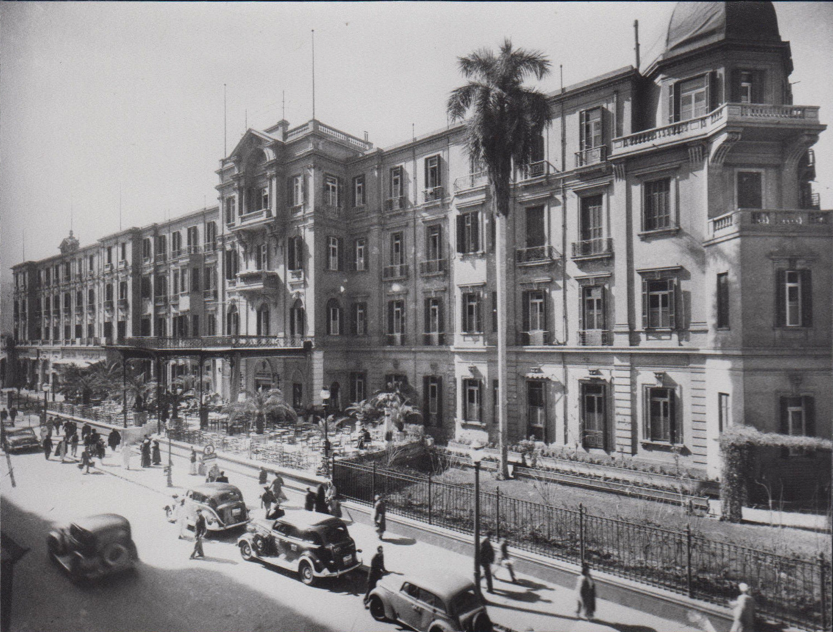Henry Field, physical anthropologist and archaeologist (and great nephew of department store founder and philanthropist Marshall Field as in, the Field Museum of Natural History) was born in Chicago but grew up and was educated in England.
Henry’s mother, Minna Field, while still a student at the Misses Masters’ School in New York, had eloped with a Yalie with a million dollar inheritance. Her fortune was bigger. That marriage didn’t last long, but Minna would soon remarry, and she and her young son Henry relocated to her new husband’s estate in England, Baggrave.
Henry, who kept his mother’s maiden name, grew up amongst wealth and privilege. When not fox hunting and touring Europe, he became interested in archaeology and anthropology. For his twelfth birthday, he asked his parents to hire two laborers to dig up an ancient Saxon site on his family’s estate. The diggers uncovered a few artifacts, a hearth, and part of an old cobblestone pavement.
Field’s family connections in America and England provided him opportunities for travel and entry into elite circles. His Uncle Barbour arrange a meeting with Dr. Henry Wellcome, pharmaceutical company owner, philanthropist, and archaeologist, who told Field, “I can arrange for you to meet anyone in Europe, provided you have a question he alone can answer.” Then he added, “Go out and learn everything of something and something of everything.” (Field 1953:30)
In 1925, while still a student at Oxford, his Uncle Barbour sent him a gift of $1,000 and told Henry to go out and dig. Naturally, Field took one of his professors, physical anthropologist L.H. Dudley Buxton, and headed off to the Middle East over the Christmas Holiday. A visit to the Great Pyramids, dinner at Shepheard’s Hotel, and a train ride to the Valley of the Kings for a tour of the recently discovered tomb of King Tut from Howard Carter was just a prelude. In Jerusalem, Field and Buxton met up with Stephen Langdon for the long ride to the Mesopotamian site of Kish.

At Kish, they spent three weeks working at the dig, on the lookout for human skeletons to measure. While there, a report came in of an older site nearby. Field, Langdon, site director Mackay, and a driver hopped into their Model T Ford, and with four pickmen clinging to the running boards, drove out to conduct the first survey of the site that would become known as Jemdet Nasr.
No grand archaeological tour would be complete without a visit to see Leonard Woolley and his excavation at Ur, a meeting with Gertrude Bell in Baghdad, and a stop at the site of Babylon. After checking these off their list, Field also managed to wrangle permission to accompany a British Army patrol into the Falluja Desert. Travelling with two Rolls Royce armored cars, Buxton and Field were able to find stone flakes that proved that prehistoric peoples had once lived there.
Once back in England in early 1926, Field began planning his spring break, an Easter Holiday trip to Europe, where, with the Abbe Breuil and Dorothy Garrod, he toured Gibraltar and Spanish Paleolithic rockshelters and caves.
His actual graduation from Oxford in 1926 may have seemed somewhat anticlimactic, but, with a job as Assistant Curator of Anthropology at the Field Museum in Chicago awaiting him in the fall, Field made time for a grand tour of the museums of Germany and other European states over the summer.
Field’s scholarly interests were broad – he devoted much time, effort, and museum funds to both Europe and the Middle East, to Paleolithic archaeology and to the earliest civilizations, and to the physical anthropology of prehistoric and modern populations. During all his travels, he sought to take anthropometric measurements of local people, and to measure the skulls found in prehistoric and more recent burials.
Beginning in 1928 he returned to Iraq to work at Kish and Jemdet Nasr (the rare film below shows excavation at Kish in 1928), but much of his time in the late 1920s and early 1930s was consumed by planning and executing two major new exhibits at the Field Museum, timed to coincide with the Chicago World’s Fair of 1933-1934.
The Hall of Prehistoric Man required many trips by Field to Europe to visit archaeological sites and museums, meet with archaeologists, and purchase artifacts. For the Hall of the Races of Mankind, he planned to have over 100 life-sized sculptures and busts, each depicting an example of a different “race” of humans. Sculptor Malvina Hoffman was selected for this daunting task.
In the 1940s, as America’s entry into World War II approached, President Franklin Roosevelt said to him “I need a tame anthropologist on my staff” and Henry Field began working for the White House. As Anthropologist to the President, he directed the production of research guides that taught soldiers how to behave while stationed in the exotic countries of the Middle East. His duties expanded to include research on shark repellent, survival kits (bibles and song books on waterproof paper were included in lifeboat supplies), signaling mirrors, rockets, and napalm. Later in the war, Field became the director of the top secret “M” project for the Special Intelligence Unit of the White House, tasked by President Roosevelt with researching potential resettlement areas for war refugees in North Africa and the Middle East.
After World War II, Field would hold several other positions, continue to travel, and participate in additional expeditions in the Middle East and Africa, before settling in at the University of Miami in 1966.
References:
Field, Henry
1953 The Track of Man. Doubleday & Company, Inc., Garden City, New York.
Heise, Kenan
1986 “Obituary: Memorial Service for Harry Field, World-renowned Explorer And Author” Chicago Tribune.